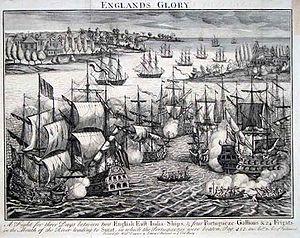Part of Portuguese battles in the Indian Ocean (1612)
This article needs additional citations for verification. Please help improve this article by adding citations to reliable sources. Unsourced material may be challenged and removed. Find sources: "Battle of Swally" – news · newspapers · books · scholar · JSTOR (September 2014) (Learn how and when to remove this message) |
| Battle of Swally | |||||||
|---|---|---|---|---|---|---|---|
| Part of Portuguese battles in the Indian Ocean | |||||||
 England's Glory, etching by William Rayner (1699–1761) | |||||||
| |||||||
| Belligerents | |||||||
| East India Company | Portugal | ||||||
| Commanders and leaders | |||||||
| Thomas Best | Unknown | ||||||
| Strength | |||||||
| 4 galleons |
4 galleons 26 barks | ||||||
| Casualties and losses | |||||||
| Unknown killed and wounded |
Unknown killed and wounded 3 galleons beached 1 bark destroyed | ||||||
Portuguese battles in the Indian Ocean | |
|---|---|
| |
The naval Battle of Swally, also known as Battle of Suvali, took place on 29–30 November 1612 off the coast of Suvali (anglicised to Swally) a village near the Surat city (now in Gujarat, India) and was a victory for four English East India Company galleons over four Portuguese galleons and 26 barks (rowing vessels with no armament).